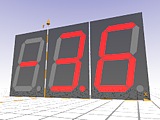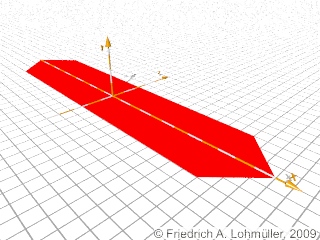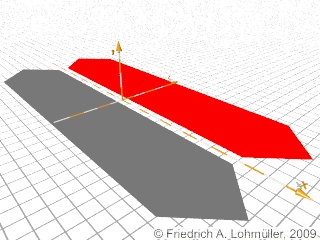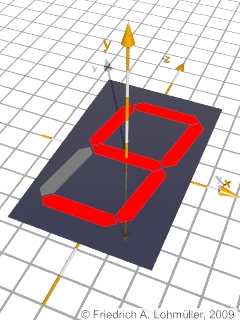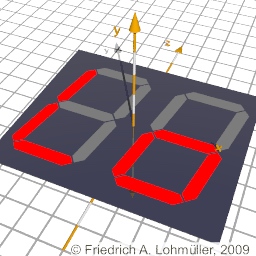Step 3: Seven_Segment_LED macro:
The following macro uses the previous macro "SS7_Element(...)"!
//--------------------------------------------
#macro Seven_Segment( SS_Number,
SS_Angle,
SS_Background_Scale,
SS_Light_Color,
SS_Shade_Color,
SS_Background_Color,
) //----------------------
//--------------------------------------------
#local SS_Len = 6.2;
#local D = 0.0001; // just a little bit !!
#local Shear_Factor = tan(radians(SS_Angle));
//---------------------------------------------
// The sequence of the elements:
// - 1
// / / 6 2
// - 7
// / / 5 3
// - 4
//---------------------------------------------
#switch (SS_Number)
#case(0)
#local Lights_On = array [7] {1,1,1,1,1,1,0}
#break
#case(1)
#local Lights_On = array [7] {0,1,1,0,0,0,0}
#break
#case(2)
#local Lights_On = array [7] {1,1,0,1,1,0,1}
#break
#case(3)
#local Lights_On = array [7] {1,1,1,1,0,0,1}
#break
#case(4)
#local Lights_On = array [7] {0,1,1,0,0,1,1}
#break
#case(5)
#local Lights_On = array [7] {1,0,1,1,0,1,1}
#break
#case(6)
#local Lights_On = array [7] {1,0,1,1,1,1,1}
#break
#case(7)
#local Lights_On = array [7] {1,1,1,0,0,0,0}
#break
#case(8)
#local Lights_On = array [7] {1,1,1,1,1,1,1}
#break
#case(9)
#local Lights_On = array [7] {1,1,1,1,0,1,1}
#break
#else // nothing - all off!!!
#local Lights_On = array [7] {0,0,0,0,0,0,0}
#break
#end // end of switch for arrays
//---------------------------------------
#macro Light_Color(Num)
#if(Lights_On[Num] = 1) SS_Light_Color
#else SS_Shade_Color
#end
#end //--------------------- end of macro
union{
union{
object{ S7_Element( Light_Color(1-1))
translate<0,0, SS_Len> }
object{ S7_Element( Light_Color(7-1))
translate<0,0, 0> }
object{ S7_Element( Light_Color(4-1))
translate<0,0,-SS_Len> }
object{ S7_Element( Light_Color(2-1))
rotate<0,90,0>
translate< SS_Len/2,0, SS_Len/2>}
object{ S7_Element( Light_Color(3-1))
rotate<0,90,0>
translate< SS_Len/2,0,-SS_Len/2>}
object{ S7_Element( Light_Color(6-1))
rotate<0,90,0>
translate<-SS_Len/2,0, SS_Len/2>}
object{ S7_Element( Light_Color(5-1))
rotate<0,90,0>
translate<-SS_Len/2,0,-SS_Len/2>}
//*)
} // end LEDs
box{ <-SS_Len/2,-0.01 ,-SS_Len>,
< SS_Len/2,-0.0000001, SS_Len>
scale SS_Background_Scale
texture {SS_Background_Color}}
translate<0,D,0>
} // end of union
#end //---------------------- end of macro
//----------------------------------------
#declare Active_Texture = // red
texture{
pigment{ color rgb< 1,0,0>*1.2}
finish { ambient .9 diffuse .1 phong 1}
} // end of texture
#declare Inactive_Texture = // gray
texture{
pigment{ color rgb<1,1,1>*0.3}
finish { phong 1 reflection 0.00}
} // end of texture
#declare Background_Texture = // ~black
texture{
pigment{ color rgb<1,1,1>*0.05}
finish { phong 1 reflection 0.10}
} // end of texture
|
7-Segment LCD
Additional Step:
Sheared Seven_Segments
If we add to our macro at the mark "//*)"
the sheering matrix
matrix< 1, 0, 0, // matrix-shear_z_to_x
0, 1, 0,
Shear_Factor, 0, 1,
0, 0, 0 >
we have to addapt the background panel by
scaling it with
< 1.70, 10, 1.40>
A sheared 7-Segment LCD.
Sure you can enable your LCD to present also some non numerical important signs:
A Lo-7-Segment LCD. :-)
Well, now it's up to you to make it with more digits and more perfect like this:
A 7-segment LCD with 4 digits and points.
|
